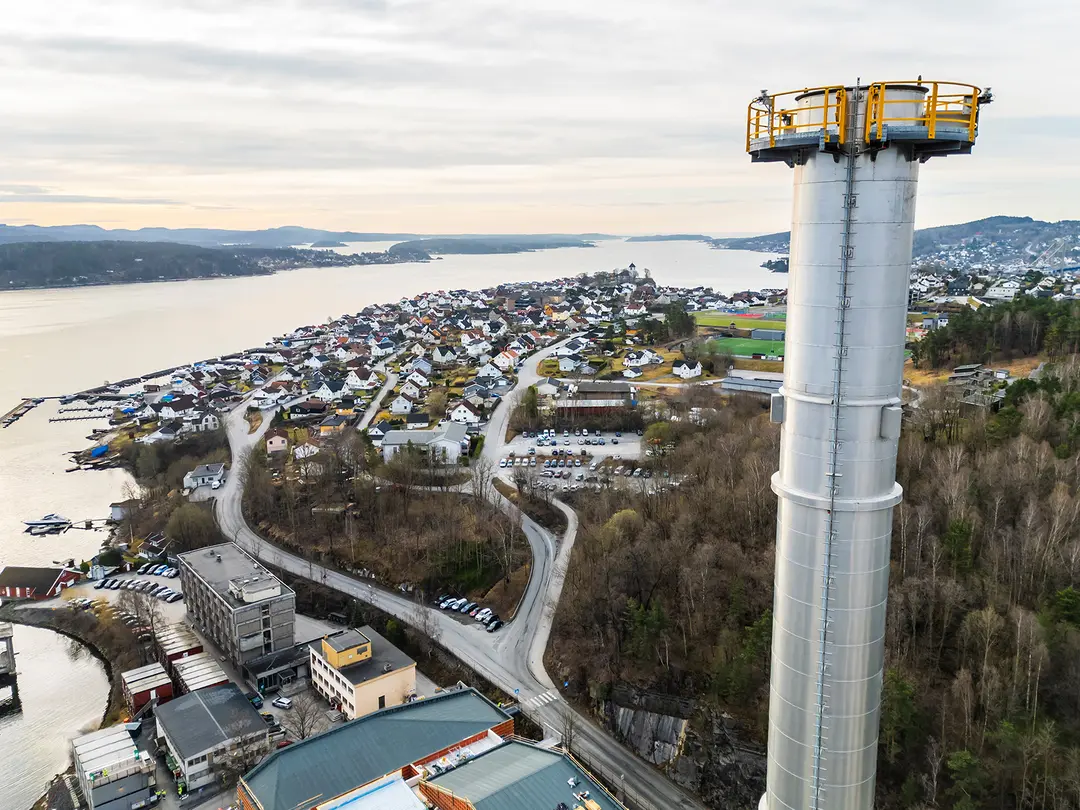Decarbonising cement is one of the most complex tasks in the Green Transition. At Heidelberg Materials, we are addressing this challenge with our full energy.
Deploying carbon capture, utilisation, and storage (CCUS) is of utmost importance for the cement industry, since ⅔ of the direct emissions come from the calcination of limestone into cement clinker during the burning process in the cement kiln. Because we cannot change chemistry, these emissions are unavoidable. At Heidelberg Materials, we diligently optimise our products and processes through research and technology to ensure we attain the lowest possible CO₂ footprint.
Despite these significant efforts, the remaining emissions require additional measures. CCUS is therefore not only a necessary prerequisite to achieve net-zero emissions in our sector – it is also pivotal for the transition phase as we continue to innovate. With this technology, we can move towards offering carbon-captured net-zero products and have the potential to completely transform cement production, enabling a whole new level of CO₂ reduction.
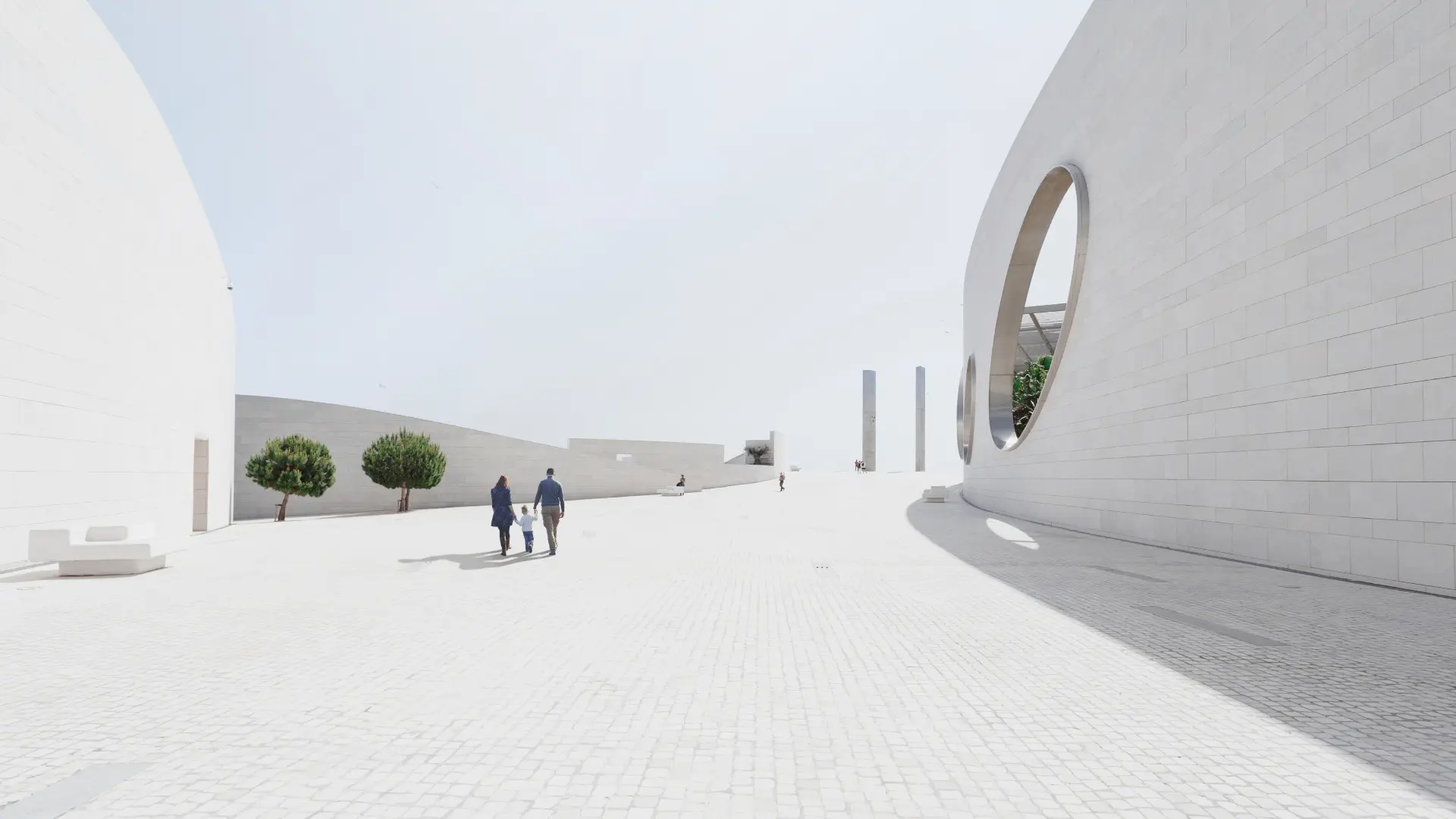
evoZero®: The world’s first carbon captured cement
We’re taking the lead in the decarbonisation of our sector. With our Brevik CCS project, we’re pioneering carbon capture and storage in our industry at scale. Our new evoZero® brand solidifies our standing as the first company in the world to offer carbon captured cement.
CCUS: crucial to our climate strategy
We officially inaugurated Brevik CCS in Norway in mid-June 2025. It is the world’s first industrial-scale carbon capture and storage (CCS) facility in the cement industry.
Among others, these projects include:
Net-zero by 2050
CCUS is a key component of our climate strategy. We will offer carbon captured near-zero concrete across our entire product portfolio by 2050 at the latest. In doing so, we are focusing on a combination of measures: in addition to CCUS, we are focusing on the increased use of substitute fuels and alternative secondary cementitious materials (including recycled materials).
What is Carbon Capture (CC)?
Our carbon capture projects focus on the sequestration of high-purity CO₂ from the clinker production process.
Using carbon capture, we remove the CO₂ from major emission sources. Thus we reduce the CO₂ emissions that are released into the atmosphere. We store the captured CO₂ permanently in safe underground geological formations.
The Brevik cement plant uses a mixture of water and organic amine solvents to absorb the CO₂.
This process is also used for other CO₂ sources: from gas, coal, cement, refineries, and waste-to-energy to hydrogen and other process industries.
CO₂ storage under the ground (in German)
What is CCU?
In our carbon capture and utilisation activities, we focus on the use of captured CO₂ for applications such as the production of synthetic fuels, the cultivation of microalgae, or the recarbonation of recycled concrete.
What is CCS?
Carbon capture and storage refers to storing captured CO₂ permanently and safely in suitable geological formations.
What is CCUS?
Our carbon capture, utilisation, and storage projects cover the entire value chain – from capture, transport, and storage to utilisation of the captured CO₂.

CCUS Experience
Discover what’s possible when cutting-edge technology meets bold ambition, captured for the first time in a unique portal.
Our CCUS locations
Heidelberg Materials is a global leader in carbon capture, utilisation and storage (CCUS). We’re scaling innovative solutions to decarbonise cement production, from
- operational plants to
- projects at or close to the final investment decision,
- advanced development, and
- pilot stages.
Operational
Brevik, Norway: Brevik CCS
In Brevik, we built the world’s first industrial-scale carbon capture and storage (CCS) facility at a cement plant. Thanks to the clear support of the government, social acceptance of CCS technology in Norway, and successful cooperation with the authorities, the project is now at an operational stage.
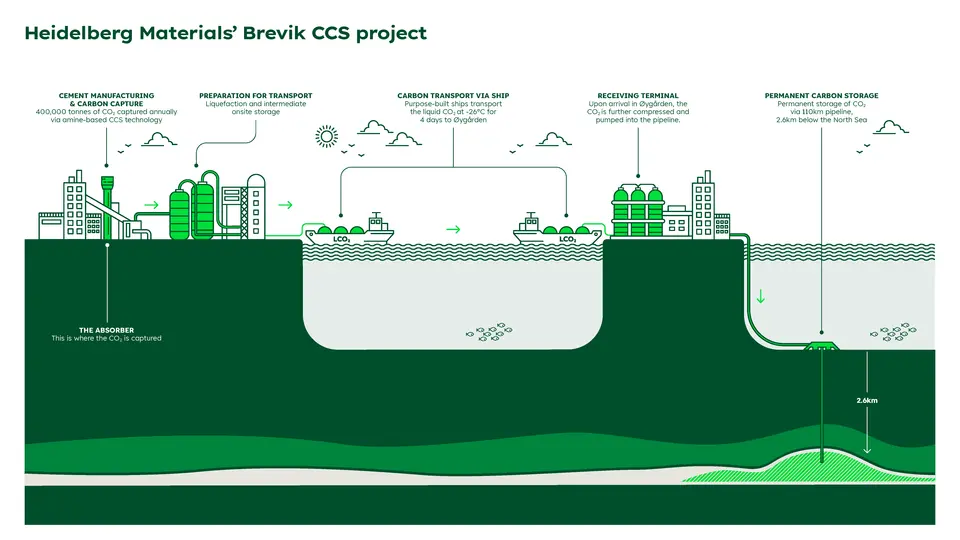
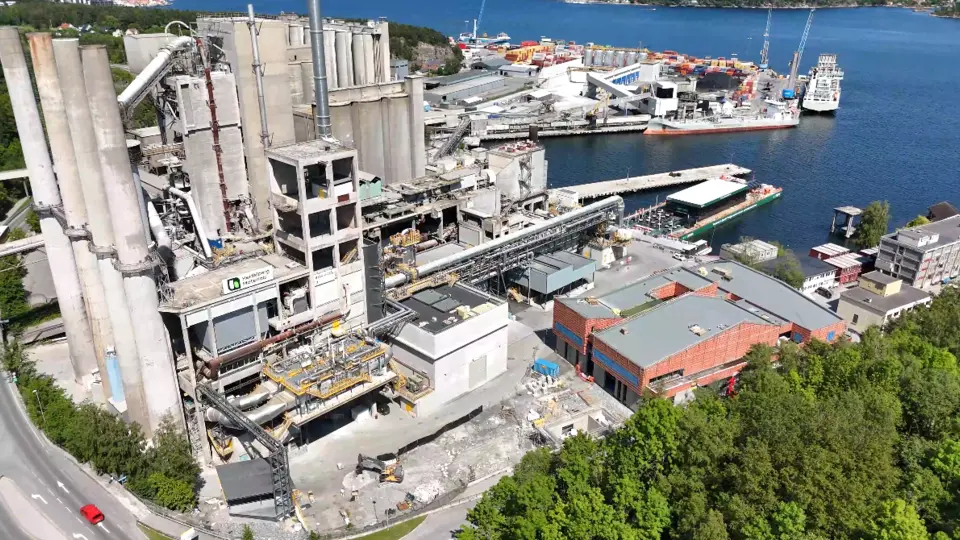
Lengfurt, Germany: Cap2U
As part of a joint venture, Heidelberg Materials and Linde aim to put the world’s first industrial-scale CCU facility in the cement industry into operation at the Lengfurt cement plant in 2025. The facility will enable the captured CO₂ from cement production to be reused as a valuable raw material in manufacturing applications. Due to its purity, the processed gas will be suitable for use in both the food and chemical industries.
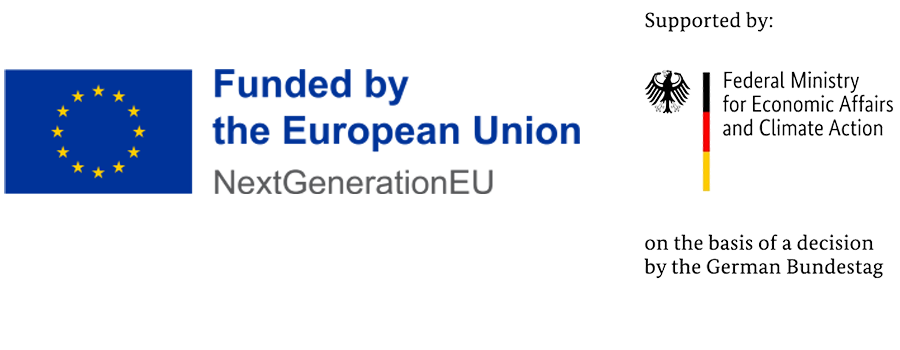
Final investment decision (FID) stage
Padeswood, UK: Padeswood CCS
We are planning a carbon capture facility at our Padeswood cement plant. In cooperation with the government-sponsored HyNet North West consortium, it will be connected to the proposed CO₂ transport and storage system. This project will be implemented using hydrogen as an energy source. A feasibility study has been conducted to establish a clear basis for planning and provide a cost estimate for the next phase. In March 2023, the project qualified for funding from the UK Department for Energy Security and Net Zero, and detailed planning has begun.
Close to FID stage
Edmonton, Canada
At our cement plant in Edmonton, we are developing North America’s first industrial-scale carbon capture, utilisation, and storage solution in the cement industry. In the future, we intend to capture CO₂ from the cement kiln and the connected combined heat and power (CHP) plant. Heidelberg Materials and Enbridge Inc. will collaborate on a pipeline-based transport and storage solution for the captured CO₂. A detailed FEED study is being carried out before the final investment decision is made.

Advanced development
Devnya, Bulgaria: ANRAV
ANRAV aims to be the first full-chain CCUS project in Eastern Europe. It will connect carbon capture facilities at the Bulgarian cement plant of Heidelberg Materials’ subsidiary Devnya Cement near Varna with offshore storage sites under the Black Sea via a pipeline system. The project is carried out jointly with the oil and gas company Petroceltic. The EU Innovation Fund will support Heidelberg Materials and Petroceltic with financing of around €190 million, supplementing the substantial contributions made by both partners.
Geseke, Germany: GeZero
Heidelberg Materials’ GeZero project in Geseke will be supported by the EU Innovation Fund. GeZero will model a solution for inland industrial sites that are not in close proximity to the coast or a waterway. The project also includes a transport solution to bridge the gap until the necessary pipeline infrastructure is available. The facility is scheduled to go into operation in 2029. Once captured, the CO₂ will be transported to a distribution hub in Wilhelmshaven and from there to offshore storage sites in the North Sea.

Slite, Sweden: Slite CCS
By 2030, we plan to develop a completely decarbonised cement plant at our site in Slite on the island of Gotland. The facility will be designed to capture up to 1.8 million tonnes of CO₂ per year, equivalent to the plant’s total emissions. In addition, the use of biobased fuels will be increased. After a feasibility study addressed questions concerning technology choices, environmental impact, legal aspects, financing, logistics, and energy supply, the project has now entered a more detailed engineering phase. The aim is to transport the captured CO₂ to a storage site below the North Sea.
Antoing, Belgium: Anthemis
Heidelberg Materials plans to equip its cement plant in Antoing, Belgium, with an innovative hybrid carbon capture unit. The second-generation OxyCal concept combines the oxyfuel and amine capture technology in one unit that does not require an additional preheater tower. This reduces the amount of structural steel and concrete required, considerably improving the resource efficiency of the system. Once operational, the technology will reduce CO₂ emissions from Antoing by more than 97%.
Airvault, France: AirvaultGOCO₂
The AirvaultGOCO₂ project is part of the large-scale GOCO₂ initiative to capture and transport CO₂ from industrial sources and decarbonise the West of France. The CO₂ captured in Airvault will be transported by pipeline to the port of Saint-Nazaire, liquefied and then transported by ship to storage under the North Sea. The biogenic part of the captured CO₂ will be used by a third party in Saint-Nazaire for the production of e-fuels, which are essential for sustainable transport by air and sea. The aim is to capture the first tonnes of CO₂ in 2030.
Mitchell, Indiana, USA
In the project in Mitchell, 95% of the CO₂ emissions from the recently modernised production facility will be captured and stored in a nearby onshore reservoir in the Illinois Basin. A feasibility study is being carried out at the site to advance the carbon capture project. In addition to evaluating the cost and performance of the overall project, the study will examine social, economic, and environmental impacts. Funding for the study has been granted by the US Department of Energy.
Rezzato, Italy
Heidelberg Materials is studying carbon capture at its Rezzato-Mazzano plant in Italy to produce net-zero cement. CO₂ will be stored at the Ravenna CCS hub under the Adriatic Sea. The project targets over 95% emissions capture, supported by Eni and Snam. Ravenna’s hub is central to CCS in the Mediterranean.
Safi, Morocco
At our Safi cement plant in Morocco, we are running a large-scale research and demonstration project using CO₂ captured from the cement kiln to cultivate microalgae for the production of fish food and other animal feed. We currently produce approximately 25 tonnes of dried microalgae annually on 0.5 hectares of land in Safi. The algae farm is operated by a local team. We launched the first product on the market in 2023. Based on market interest, the plan is to gradually expand capacity by 2026.
Large-scale technology pilot projects
Ennigerloh, Germany: LEILAC
The EU-funded LEILAC (Low Emissions Intensity Lime And Cement) project, in which Heidelberg Materials is one of the strategic partners, aims to demonstrate the technical and economic feasibility of process technology designed to capture CO₂ in its purest form when it is released as the raw material is heated. Following the successful completion of process trials in Lixhe, Belgium, the LEILAC technology is now being transferred to industrial scale. In collaboration with Australian technology company Calix and a European consortium, Heidelberg Materials will now build a facility four times as large at the Ennigerloh plant in Germany.
Devnya, Bulgaria: ANRAV.beta
A pilot carbon capture installation is currently under construction at Heidelberg Materials’ plant in Devnya. It will be a key proof of concept for the company’s first full-chain carbon capture, utilisation, and storage (CCUS) project in Eastern Europe. The unit has been designed to prove not only the efficiency of the new OxyCal capture technology, but also its scalability to ANRAV CCUS and other projects. Construction of the pilot unit is expected to take just a few months, with the subsequent demonstration phase scheduled to last 12 to 24 months.
Mergelstetten, Germany: catch4climate
Together with three other European cement manufacturers, Heidelberg Materials is participating in a research project to construct an oxyfuel kiln line. Alongside Buzzi/Dyckerhoff, Schwenk, and Vicat, Heidelberg Materials aims to create the necessary conditions for the large-scale use of low-energy, cost-effective carbon capture technologies at cement plants. A semiindustrial- scale demonstration plant is currently under construction on the site of the Mergelstetten cement plant. In addition to testing the pure oxyfuel technology, some of the CO₂ obtained will be used to manufacture climate-neutral synthetic fuels, such as kerosene for aviation.
Key carbon capture technologies
We are exploring multiple carbon capture technologies to reduce emissions from cement production. These include amine-based post-combustion capture, oxyfuel combustion, and direct separation – each offering unique advantages in efficiency, purity, and integration into existing processes.
Amine technology
With amine technology for carbon capture, sulphur and nitrogen oxides are filtered out of the flue gas at the end of the conventional combustion process. The CO₂ is then separated from the remaining exhaust gas via a washing system using liquid amine.
After separation, the CO₂ with a purity of about 99% percent can be used as a raw material or stored.
Oxyfuel technology
Clinker-burning technique in which pure oxygen is introduced into the kiln instead of air. This leads to a CO₂ content of up to 90% in the exhaust gases, which can be further upgraded to 99%.
The aim is to capture the CO₂ in a more energy-efficient way than by post-combustion capture, as no additional heat is required.
Direct separation
Direct separation technology is supposed to enable the capture of process-related CO₂ without additional use of heat or any other commodity.
A special reactor replaces the conventional calciner of the kiln system to separate the CO₂ already during calcination.


